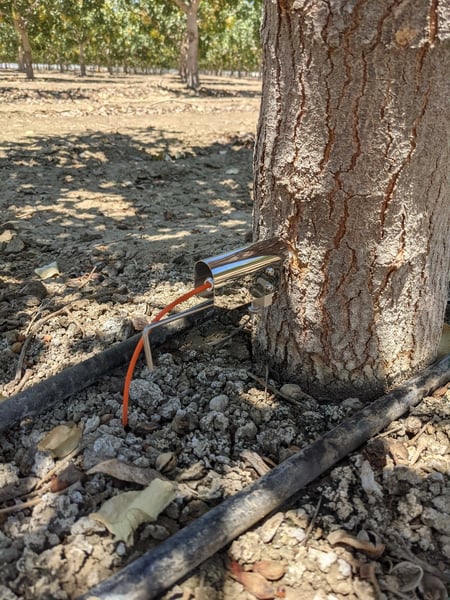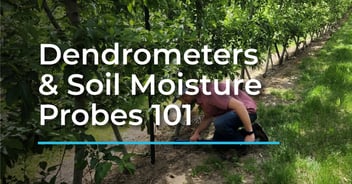Why yes, Semios does offer dendrometers.
But, until now, we have hesitated to offer them on a large scale. We wanted to spend some extra time evaluating past research, current industry standards, and performing research of our own to improve the reliability and utility of this novel contraption.
What are dendrometers?
Dendrometers come in two flavors: trunk/stem dendrometers and fruit size dendrometers. While Semios offers both, we are going to focus on the trunk dendrometer in this article.
Trunk dendrometers (hereafter dendrometers, or dendos) are a device that is attached to the side of a tree and measure the minuscule changes in the diameter of a tree's trunk as water availability, tree condition, weather, and other influences change throughout a day, night, and season.
 Example of a trunk dendrometer attached to the side of a pistachio tree in a California orchard
Example of a trunk dendrometer attached to the side of a pistachio tree in a California orchard
What are dendrometers used for?
In measuring the conditions surrounding the proper management of irrigation, we have become pretty good at measuring the environment via evapotranspiration and soils via soil moisture sensors.
What we are lacking is a good measurement of the tree or crop. Without that part of the story, we are missing critical information that can help us to precisely control our crops and water. Currently, stem-water potential measured by a pressure bomb is the mainstay for this information, but it is time-consuming, not very accurate, and cannot currently be measured in real-time.
The dendrometer is meant to displace pressure bombs and provide real-time measurements of one aspect of a tree’s water state.
What are some issues with using dendrometers?
Unfortunately, dendos have their own set of complicated issues.
First off, measurements from one tree to the next in the same field vary greatly.
Second, the device itself hangs awkwardly and vulnerably off the side of the tree.
And third but most importantly, the data it records are completely new and don’t correspond to any research that would guide us to know what the data means. We have a century of data on soil moisture, and decades of research justifying stem-water potential, but with dendos all we have are some loose correlations; trunks of trees that have a deficit of water shrink, to a point and trees with plenty of water expand, to a point. But we haven’t found a way to make it correlate with anything we know already, like stem-water potential.
Everyone agrees, the shrink and swell due to water has meaning, but we need to draw it out still. So, here is the Semios take on the dendrometer:
- It provides feedback. The greatest thing we can do for irrigation employees is to get them thinking about irrigation, planning and figuring out the best methods. Irrigation absolutely causes a trunk to swell, and for some, the idea that they are making a tree fat with water makes a lot more sense than filling the soil up with water. The best results from using dendrometers, so far, are due exactly to this. Instead of irrigating according to the schedule they have always used, irrigators are fascinated with the idea of filling a tree with water and will check back daily or more often to see how their actions are affecting it.
- Semios’ team of high-powered brainiac data scientists are making continual improvements on models to draw out more meaning. Raw dendrometer data is messy. Processing the data, by drawing out key components, comparing certain aspects, or by applying other complimenting data can uncover the meaningful information that can give the data context and unlock exact ranges and indicators that can give new and real insight into what the plant is experiencing. With the data already flowing in from our dendrometers we have been able to improve upon existing models and provide data that is free from biases that occur due to limits of flex due to the strength of wood.
- A farm is a harsh environment. Any equipment in the field is subject to damage. However, we feel confident in the equipment and install methods used to make it unlikely that damage will occur. If damage does occur, systems are already in place to detect the damage and dispatch our robust service team to correct the problem.
- Even if we don’t yet know the exact meaning of the dendo data, it can help indicate how a tree responds to the environment around it. Enterprising growers very well may make observations that can steer the research and understanding in the correct direction. Beyond that, the more data we have coming in, the more easily we can begin to draw out the meaning.

A view of some of the plant stress monitoring tools Semios provides to users based on real-time dendrometer data from their orchard.
Is one dendrometer per irrigation zone enough to get good data?
This is a question we often get asked. This stems from a practice in the industry of placing multiple units in one zone.
As an analogy, can you imagine if your employer placed heartbeat monitors on three employees and then averaged their heartbeats to decide if they had a healthy workplace? First, three employees is not enough of a sample size and heartbeats from three individuals don’t really average, an average number would simply make it harder to draw any conclusions.
In the research we have performed, we feel confident that multiple dendrometers do not increase the quality of data enough to justify the increase in the cost of multiple devices and one dendrometer placed thoughtfully in a field provides enough quality data to give the needed insight. It is our opinion that multiple dendrometers are used in the industry as a failsafe in case one or two of the devices fail during the season. Our error detection system and technical staff are well equipped to discover and repair any issue quickly enough to not lose any valuable data if a malfunction does occur.
Who should get a dendrometer for their farm?
This is really a personal question. If you are bogged down with all of the duties you have to perform already, I say wait and let us figure these out a little more for you first.
But, if you live and breathe data, enjoy being on the absolute cutting edge, and want another puzzle to work out that can possibly benefit your operation, then, go for it. We look forward to hearing your insights as we continue to work together to sort out the meaning more completely. Learn more about the work Semios is doing to improve dendrometers with the Semios Water Stress Index.
Learn More
Improving Dendrometers With The Semios Water Stress Index
Semios Plant Stress Monitoring Solution - Trunk, Stem & Fruit Dendrometers



